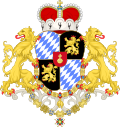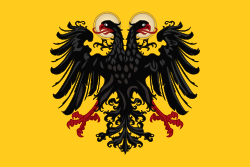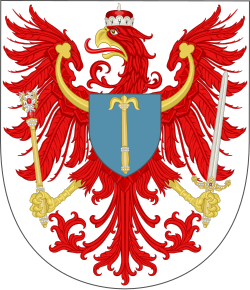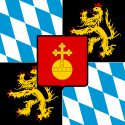Bavorské kurfiřtství
| Bavorské kurfiřtství Kurfürstentum Bayern
| |||||||||||||||
Geografie
| |||||||||||||||
| Obyvatelstvo | |||||||||||||||
Národnostní složení | Bavorští Němci | ||||||||||||||
| Státní útvar | |||||||||||||||
| Státní útvary a území | |||||||||||||||
| |||||||||||||||
Bavorské kurfiřtství (německy Kurfürstentum Bayern) je právně nepřesný název pro Bavorské vévodství (německy Herzogtum Bayern), používaný od roku 1623, kdy bavorští vévodové získali kurfiřtský hlas, až do 1. ledna 1806, kdy vzniklo Bavorské království. Po sloučení s Falckým kurfiřtstvím v roce 1778 se také nazývalo Doppel-Kurfürstentum Pfalz-Bayern (Dvojité falcko-bavorské kurfiřtství).
Historie
V roce 1620 porazila vojska Katolické ligy pod velením bavorského vojevůdce Tillyho v bitvě na Bílé hoře české protestantské stavy. Jako výraz díků získal v roce 1623 vévoda Maxmilián I., hlava Katolické ligy a horlivý straník Habsburků, kurfiřtský hlas, odejmutý jeho vzdálenému příbuznému Fridrichu V. Falckému a Horní i Dolní Falc, jež na něm dobyl. Vestfálský mír v roce 1648 mu potvrdil jak kurfiřtská práva, tak odškodnění v podobě území Horní Falce. Dolní Falc byla navrácena Fridrichovu synovi Ludvíkovi, pro něhož byl vytvořen osmý kurfiřtský hlas.
Symbolika
- kurfiřtský erb:
Odkazy
Reference
V tomto článku byl použit překlad textu z článku Kurfürstentum Bayern na německé Wikipedii.
Související články
Externí odkazy
 Obrázky, zvuky či videa k tématu Bavorské kurfiřtství na Wikimedia Commons
Obrázky, zvuky či videa k tématu Bavorské kurfiřtství na Wikimedia Commons - (německy) Dějiny Bavorska na Geschichte.hdbg.de
Média použitá na této stránce
Autor: Nomadic1, Licence: CC BY-SA 4.0
Coat of arms of the Roman Catholic Diocese of Würzburg
Flag of Bavaria (striped)
Autor: David Liuzzo, eagle by N3MO, Licence: CC BY-SA 3.0
Banner of the Holy Roman Empire, double headed eagle with halos (1400-1806)
Autor: Ziegelbrenner, Licence: CC BY-SA 3.0
Coats of arms of the electorate of Salzburg. 1+2: prince archbishop of Salzburg; 3. prince-bishop of Eichstätt; 4. prince-bishop of Passau; 5. prince-provost of Berchtesgaden; middle: 1 Old-Hungary; 2. New-Hungary; 3: Bohemia; 4: county of Tirol; 5: grand-duchy of Tuscany; 5: duchy of Lorraine; 5: county of Habsburg; heart: Austria
Autor: Tretinville, Licence: CC BY-SA 3.0
Blason de Maximilien Joseph de Bavière de 1804 à 1806 (Elector of Bavaria Reign 16 February 1799 – 6 August 1806) (King of Bavaria Reign 1 January 1806 – 13 October 1825)
Coat of arms of Baden, Markgrafschaft
Autor: Adelbrecht and Heralder, elements by Sodacan, Licence: CC BY-SA 3.0
Shield of Arms of the Arch-Marshal of the Holy Roman Empire.
Gold crown
Autor: Gundan, + my own edits, Licence: CC BY-SA 4.0
I principati elettorali del Sacro Romano Impero nel 1618
Autor: Ad17minstral, Licence: CC BY-SA 4.0
Arms of electoral Württemberg augmented with heraldic insignia of the imperial office of the Banner-bearer.
Coat of arms of Bamberg
Autor: Ad17minstral, Licence: CC BY-SA 4.0
Silver Bohemian lion presenting a crown symbolizing the imperial crown of the Holy Roman Empire presented by the Arch Cupbearer—the King of Bohemia—at imperial coronations. Restored from hand-drawn Medieval armorials.
Autor: Adelbrecht and Heralder, elements by Sodacan, Licence: CC BY-SA 3.0
Shield of Arms of the Arch-Treasurer of the Holy Roman Empire.
Flag of the Grandduchy of Wurzburg.
Autor:
- HRR_1648_Glatz.PNG: Roke (map), Hanno Sandvik (addition of colours)
- derivative work: John Kenney (talk)
Map of the Holy Roman Empire, 1648, with the electorate of Bavaria highlighted
Rautenflagge (24 Rauten)
Autor: Glasshouse, Licence: CC BY-SA 4.0
Shield of the Prussian State of Brandenburg
Autor: Adelbrecht and Heralder, elements by Sodacan, Licence: CC BY-SA 3.0
Shield of Arms of the Arch-Steward of the Holy Roman Empire.
Electoral Standard of Bavaria (1623-1806)
Autor: Adelbrecht & Heralder, elements Sodacan, Licence: CC BY-SA 3.0
of Charles VII Albert, Holy Roman Emperor
Autor: MostEpic, Licence: CC BY-SA 4.0
Shield of Arms of the Arch-Bannerbearer of the Holy Roman Empire.
Autor: Ipankonin, Licence: CC BY-SA 3.0
Coat of arms of the Archbishopric of Mainz
Blazon: Gules a wheel with six spokes argent.Autor: MostEpic, Licence: CC BY-SA 4.0
Coat of arms of the house of Hesse-Kassel
Autor: Sir Iain, inspiration from User:Sodacan, Licence: CC BY-SA 3.0
War flag of the Electorate of the Palatinate in 1604.
Autor: Adelbrecht and Heralder, elements by Sodacan, Licence: CC BY-SA 3.0
Ancient Shield of Arms of the Arch-Chamberlain of the Holy Roman Empire.
(c) Katepanomegas, CC BY-SA 3.0
Arms of the duke-elector Maximilian I. Josepf of Bavaria, count palatine of the Rhine, etc. from 1799 to 1804. Sources :
Autor: ชาวไทย, Licence: CC BY-SA 4.0
Coat of Arms of Electorate of Cologne and the Archdiocese of Cologne.
Autor: Glasshouse, Licence: CC BY-SA 4.0
Coat of Arms of the Electorate of Bavaria 1753
Autor:
- Royal_Arms_of_the_Kingdom_of_Hanover.svg: Sodacan
- derivative work: Sodacan (talk)
Royal Shield of Arms of the Kingdom of Hanover











































